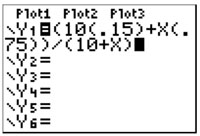We have three methods that can be used to find the answer to this question.
We can substitute 30 ml in for x and use algebra/arithmetic to simplify: f(x) =
numerator 10(.15) + 30(.75)m denominator 10 + 36
10(.15) + 30(.75)m
10 + 36
=
numerator 24 denominator 40
24
40
= .6
The resulting solution is 60% acid.
We can enter the function into the graphing calculator and use either the graph or the table to find the answer.
Remember that parentheses are needed to tell the calculator to group the numerator and to group the denominator:

If graphing, adjust the window, use the trace button and type in the x-value you are looking for, and enter.

If using the table, set the table to start at the x-value you are looking for, and select table.

All three methods show that adding 30 ml of the 75% acid solution to the 10 ml of the 15% acid solution would result in 40 ml of a 60% acid solution.
Let's look at those three methods to find this answer.
Algebraically, we need to substitute 36 into the function rule for y. Then, we need to solve the equation for x.
0.36 =
numerator 10(0.15) + x(0.75) denominator 10 + x
10(0.15) + x(0.75)
10 + x
3.6 + 0.36x = 1.5 + 0.75x
3.6 - 1.5 = 0.75x - 0.36x
2.1 = 0.39x
5.4 ≈ x
If using the graphing method, because you have a y-value instead of an x-value, you want to enter 36% in decimal form into y2. The graph needs to show the point of intersection. Use the calculate feature of the calculator, select the intersect feature, and enter until you see the point of intersection indicated in the calculator window.

If using the table feature, it is not necessary but could be helpful, to enter the 36% in decimal form into Y2.You will need to scroll through the table until you find 0.36 in the Y1 column. This value is not visible in the standard table, but you can see that 0.36 comes between 0.35 and 0.375 so the answer is between 5 and 6. Start the table at 5 and go by tenths instead of ones to get a more accurate answer.

All three methods give us an answer of approximately 5.4. Pedro should add about 5.4 ml of the 75% acid solution to the 10 ml of the 15% acid solution to get a solution that is 36% acid.
Adapting his function to the new situation is a review of Module 7 Lesson 5.
We'll replace 10 ml in the old equation with 18 ml, replace 0.15 with 0.25, replace 0.75 with 1 (pure acid is 100% acid and as a decimal 100% is 1). The new function is f(x) = numerator 18(0.25) + x(1) denominator 18 + x 18(0.25) + x(1) 18 + x
The three methods for finding the amount of pure acid to be added follow.


For Anita's equation we'll replace 10 ml in the old equation with 25 ml, replace .15 with .20, replace .75 with 0 (water is 0% acid). The new function is f(x) = numerator 25(0.20) + x(0) denominator 25 + x 25(0.20) + x(0) 25 + x .
The three methods for finding the amount of pure acid to be added follow.

